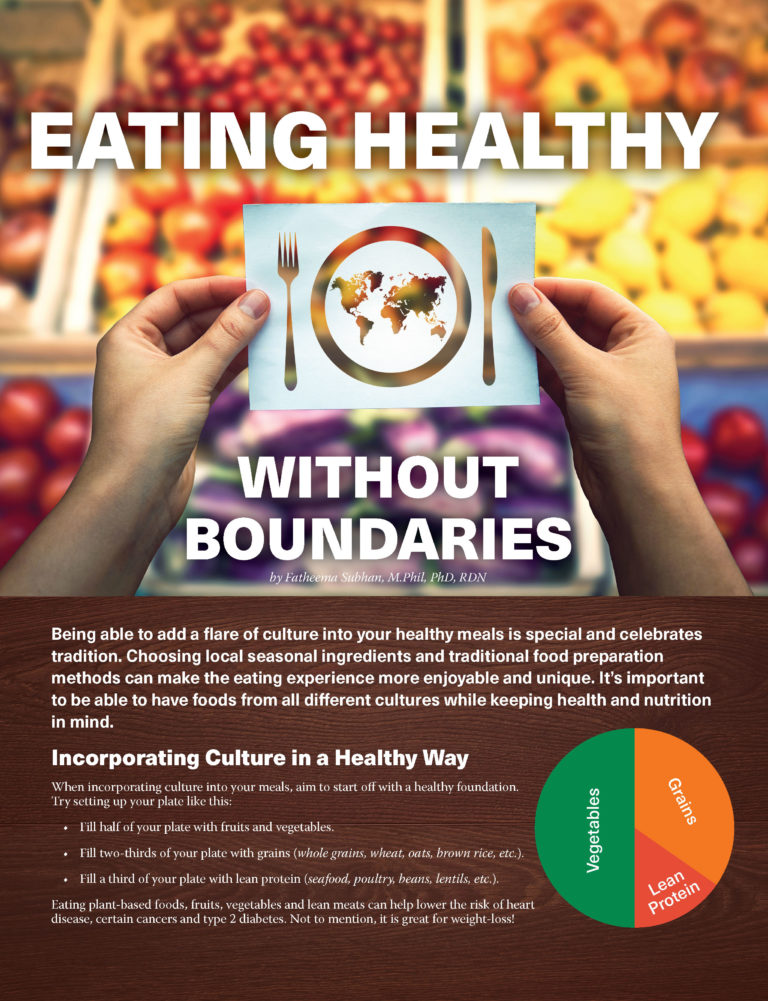Eating Healthy Without Boundaries


by Fatheema Subhan, M.Phil, PhD, RDN
Summer 2021
Being able to add a flare of culture into your healthy meals is special and celebrates tradition. Choosing local seasonal ingredients and traditional food preparation methods can make the eating experience more enjoyable and unique. It’s important to be able to have foods from all different cultures while keeping health and nutrition in mind.
Incorporating Culture in a Healthy Way
When incorporating culture into your meals, aim to start off with a healthy foundation. Try setting up your plate like this:
- Fill half of your plate with fruits and vegetables.
- Fill two-thirds of your plate with grains (whole grains, wheat, oats, brown rice, etc.).
- Fill a third of your plate with lean protein (seafood, poultry, beans, lentils, etc.).
Eating plant-based foods, fruits, vegetables and lean meats can help lower the risk of heart disease, certain cancers and type 2 diabetes. Not to mention, it is great for weight-loss!
It is possible to follow these guidelines and recommendations while choosing culturally diverse foods that are tasty, interesting and nutritious. Some examples of healthy cultural foods include:
Chinese:
- Stir-fried Vegetables: A blend of vegetables with chicken or tofu sautéed with Chinese seasonings and sauces.
- Steamed Dumplings: Dumpling wrappers filled with meat and vegetables and steamed in a pan. Serve with veggies or extra protein.
- Beef and Broccoli: A blend of beef and broccoli sautéed in a pan with Chinese seasonings and sauces.
Indian:
- Dhal: A slow-cooked lentil dish prepared with red or yellow lentils cooked with onions, tomato and spices. It can be served with rice, roti or chapati. Chapati is a flatbread made with whole wheat flour toasted on a flat griddle.
- Poriyal: A favorite South Indian stir-fried side dish prepared from fresh vegetables such as French beans, carrots or cabbage, seasoned with mustard seeds, curry leaves, freshly grated coconut and spices.
- Tandoori Chicken: A chicken entrée that is marinated with spices and yogurt and then grilled on a stovetop. Serve with vegetables.
Mediterranean:
- Hummus: A blend of chickpeas, tahini, lemon juice and garlic. Serve with naan bread, crackers or fresh vegetables such as carrots and snow peas.
- Tabbouleh: A fresh salad that comes with finely-chopped parsley, mixed with chopped tomatoes, mint, onion, bulgur, and seasoned with olive oil, lemon juice and salt.
- Bulgur Pilaf: Bulgur wheat cooked with onion, tomatoes and spices.
Mexican:
- Ceviche: Raw fish marinated in lime and lemon juice, onion, tomatoes and cilantro.
- Fajitas: Grilled chicken, fish or shrimp sautéed with onions and peppers and served with whole wheat tortillas.
- Nopales Salad: Cooked chopped cactus leaves, green onion, tomato and cilantro. Season with salt and lime juice.
Mediterranean Garden Salad with Feta and Black-eyed Peas
Serves: 10-12
Ingredients:
- Black-eyed peas – 1 can (rinsed and drained)
- Peppers – 1 red, 1 yellow, 1 orange, 1 green (chopped)
- Red onion – 1 (chopped)
- Cucumber – Cucumber (chopped)
- Cherry tomatoes – 1 cup (chopped)
- Carrot – 1 medium (chopped)
- Feta cheese – ¼ cup
Dressing:
- Olive oil – ¼ cup
- Lemon juice – 2 Tbsp.
- Lemon zest (optional)
- Garlic clove – 1 (crushed and finely chopped)
- Cilantro or Parsley – ¼ cup (chopped)
- Black pepper – to taste
- Salt – ½ tsp.
Directions:
- In a large bowl, combine black-eyed peas, peppers, cucumber, carrots, tomatoes and red onions.
- Prepare the salad dressing. In a small bowl, whisk together olive oil, lemon juice, salt, garlic, parsley and black pepper.
- Pour the dressing over the salad and mix well. Garnish with crumbled feta cheese and chill until serving.
- Serve with pita bread.
Celebrating Culture Through Food
We aren’t always taught that we can incorporate different cultures and recipes into our diet and our healthy lifestyle. It’s important to recognize that you don’t have to eat only bland foods to eat healthy. You can always spice things up! Go ahead and try a new, healthy recipe from a different culture. You never know, you might like it!
About the Author:
Fatheema Subhan, M.Phil, PhD, RDN, is an Assistant Professor at California State Polytechnic University Pomona. She is a Registered Dietitian and received her PhD in Nutrition and Metabolism from the University of Alberta, Canada. She is a CIHR Health Impact Fellowship recipient. Her research interest includes development, implementation, and evaluation of community-based nutrition interventions for diabetes management, school-based health promotion programs and maternal and infant nutrition and health. Her work aims to empower individuals and communities to be able to make nutrition education and healthcare support accessible to reduce health-inequities in ethnic minority communities.
by Sarah Muntel, RD Spring 2024 Spring has sprung, bringing sunnier and warmer days! For many, this…
Read Articleby Rachel Goldman, PhD, FTOS; Sarah Muntel, RD; and Stefanie Trilling Winter 2024 This section of Weight…
Read Articleby Kelli Richardson, RD You’ve probably heard the generic advice before: Eat your fruits and veggies. Limit…
Read Article








